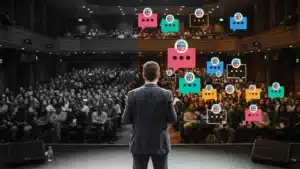
PowerPoint Presentation Examples That Actually Spark Dialogue
In a world where presentations often fall flat, the need for engaging and interactive experiences has never been more critical. Traditional PowerPoint slides can sometimes lead to one-way communication, leaving audiences disengaged and presenters frustrated. However, with the right strategies and tools, it is possible to transform these sessions into dynamic dialogues that foster interaction and connection. This article explores effective PowerPoint presentation examples that not only captivate but also encourage meaningful conversations.
The Importance of Engagement in Presentations
Engagement is the cornerstone of any successful presentation. When audience members feel involved, they are more likely to retain information and respond positively to the content being shared. This is particularly true in settings where feedback and interaction are essential, such as sales pitches, educational seminars, and corporate meetings.
Consider Jamie, a sales manager at a tech company, who regularly presents to both internal teams and prospective clients. Her goal is to create memorable presentations that not only inform but also engage her audience. Unfortunately, many presenters like Jamie often struggle with keeping their audience involved, especially in virtual settings where distractions abound.
Creating Interactive Slides
One effective way to spark dialogue is by designing interactive slides. This can include polls, quizzes, or open-ended questions that prompt audience participation. For instance, a slide could pose a thought-provoking question related to the topic at hand, inviting attendees to share their insights or experiences.
Utilizing PresEngage can significantly enhance this interactive experience. With its AI-powered, hands-free Q&A feature, presenters can address audience questions in real-time, ensuring that every voice is heard without interrupting the flow of the presentation. This not only fosters a sense of inclusivity but also ensures that valuable insights and leads are captured effortlessly.
Utilizing Technology for Seamless Interaction
Incorporating technology into presentations can greatly enhance audience engagement. For example, using SMS-based platforms allows attendees to participate without needing to download apps or create accounts. This frictionless approach encourages more people to engage, as they can simply text their questions or comments during the presentation.
Imagine a scenario where Jamie, during her presentation, shares a QR code on her slides that attendees can scan to join a live Q&A session. This instant connection eliminates barriers and encourages even the most reserved participants to contribute. Furthermore, the ability to share presentation materials via SMS ensures that attendees can revisit the content later, reinforcing their understanding and engagement.
Moreover, leveraging social media platforms during presentations can amplify engagement levels. By encouraging attendees to tweet or post their thoughts using a specific hashtag, presenters can create a dynamic conversation that extends beyond the confines of the presentation room. This not only allows for real-time feedback but also enables the audience to feel like they are part of a larger community, fostering a sense of belonging and shared experience. Jamie could even highlight some of these social media interactions live during her presentation, showcasing audience contributions and making them feel valued.
Additionally, incorporating multimedia elements such as videos, animations, or infographics can capture attention and break the monotony of traditional slide presentations. These elements can serve as powerful storytelling tools that resonate with the audience on an emotional level, making the content more relatable and memorable. For instance, Jamie could include a short video testimonial from a satisfied client, illustrating the impact of her company’s solutions in a compelling way. This not only enhances engagement but also reinforces the message she aims to convey, making her presentation more impactful.
Examples of Engaging PowerPoint Presentations
To illustrate how presentations can be transformed into engaging dialogues, consider the following examples that showcase innovative approaches to PowerPoint design and delivery.
Example 1: The Interactive Workshop
In an interactive workshop setting, presenters can design their slides to include hands-on activities. For instance, a slide could present a case study, followed by a breakout session where attendees discuss their thoughts in small groups. After the discussion, the presenter can reconvene the audience and invite groups to share their insights, creating a rich dialogue.
Using PresEngage, the presenter can seamlessly manage the Q&A process, allowing participants to ask questions about the case study or share their experiences without losing momentum. This approach not only makes the presentation more dynamic but also encourages deeper connections among participants. Additionally, incorporating real-time feedback tools can further enhance engagement; for example, using live polls to gauge audience opinions on various aspects of the case study can provide instant insight into group sentiment and foster a more interactive atmosphere.
Example 2: The Storytelling Approach
Storytelling is a powerful tool in presentations that can evoke emotions and foster engagement. By weaving a narrative throughout the slides, presenters can draw their audience into the story, making them more invested in the outcome. For instance, a sales presentation could follow a customer’s journey, highlighting challenges and successes along the way.
To enhance this storytelling technique, presenters can invite audience members to share their own stories related to the topic. This could be facilitated through real-time polls or SMS engagement, where attendees can submit their experiences or ask questions that tie back to the narrative. The result is a presentation that feels like a conversation rather than a lecture. Furthermore, incorporating multimedia elements such as video clips or audio snippets can enrich the storytelling experience, providing diverse perspectives and making the narrative more vivid and relatable to the audience.
Example 3: The Data-Driven Presentation
Data-driven presentations can often come across as dry or overwhelming. However, by presenting data in an engaging manner, presenters can spark meaningful discussions. For example, using infographics or visual storytelling techniques can make complex data more digestible and relatable.
During the presentation, the presenter can pose questions related to the data, inviting audience members to share their interpretations or experiences. By using AI-powered Q&A tools, the presenter can address these questions in real-time, ensuring that the audience feels heard and valued. This approach not only enhances understanding but also encourages collaboration and brainstorming among attendees. Additionally, integrating storytelling elements into the data presentation—such as case studies that illustrate the data in action—can help contextualize the numbers, making them more impactful and easier for the audience to grasp. By framing data within real-world scenarios, presenters can transform statistics into compelling narratives that resonate with their audience.
Strategies for Enhancing Audience Participation
To further enhance audience participation, presenters can implement several strategies that encourage dialogue and connection.
Utilizing Breakout Sessions
Breakout sessions are an effective way to foster small group discussions during a larger presentation. By dividing the audience into smaller groups, presenters can create a more intimate environment where participants feel comfortable sharing their thoughts and ideas. Each group can be tasked with discussing a specific question or topic, and then reconvened to share their insights with the larger audience.
This format not only encourages participation but also allows for a diversity of perspectives to be shared. Utilizing PresEngage can streamline the process, allowing presenters to capture questions and insights from each group effortlessly. Furthermore, facilitators can rotate among groups to provide guidance and spark deeper conversations, ensuring that all voices are heard and that the discussions remain focused and productive. This dynamic interaction can lead to richer outcomes and a more engaged audience.
Incorporating Gamification
Gamification is another powerful technique to boost audience engagement. By incorporating game-like elements into presentations, such as quizzes or competitions, presenters can create a fun and interactive atmosphere. For example, a quiz at the end of a presentation can reinforce key points while encouraging audience members to participate actively.
Using SMS platforms, attendees can submit their answers in real-time, making the experience more engaging. This approach not only reinforces learning but also fosters a sense of community among participants as they compete and collaborate. Additionally, offering small rewards or recognition for participation can further motivate attendees to engage, creating a lively and spirited environment that enhances the overall experience. By turning learning into a game, presenters can tap into the natural competitive spirit of individuals, making the session memorable and impactful.
Encouraging Open Dialogue
Creating an environment that encourages open dialogue is essential for fostering engagement. Presenters can set the tone by inviting questions and feedback throughout the presentation rather than waiting until the end. This can be facilitated through dedicated Q&A slides or prompts that encourage audience members to share their thoughts.
With AI-powered Q&A tools, presenters can manage questions efficiently, ensuring that every inquiry is addressed in real-time. This approach not only keeps the audience engaged but also creates a more collaborative atmosphere where participants feel valued and heard. Additionally, incorporating live polls or surveys during the presentation can further stimulate discussion, allowing attendees to express their opinions on various topics instantly. By actively involving the audience in the conversation, presenters can cultivate a sense of ownership over the content, leading to a more invested and enthusiastic group of participants.
Measuring Engagement and Success
To truly understand the effectiveness of a presentation, it is crucial to measure audience engagement and success. This can be achieved through various analytics tools that track participation metrics, such as question volume, audience feedback, and overall engagement levels.

Utilizing Analytics Tools
Analytics tools can provide valuable insights into audience behavior and engagement during presentations. By tracking metrics such as the number of questions asked, the types of inquiries, and participant demographics, presenters can tailor future presentations to better meet the needs of their audience.
For instance, if analytics reveal that certain topics generate more questions, presenters can focus on those areas in future sessions. This data-driven approach not only enhances the quality of presentations but also demonstrates a commitment to continuous improvement.
Gathering Feedback
Feedback is a vital component of measuring presentation success. Presenters can solicit feedback from attendees through surveys or informal discussions following the presentation. This feedback can provide insights into what worked well and what areas need improvement.
Incorporating feedback into future presentations not only enhances the overall experience but also shows attendees that their opinions are valued. This can lead to increased engagement in subsequent sessions as participants feel more invested in the process.
Continuous Improvement
Finally, the key to successful presentations lies in continuous improvement. By analyzing engagement metrics, gathering feedback, and experimenting with new techniques, presenters can refine their approach over time. This commitment to growth ensures that every presentation becomes more engaging and impactful than the last.
Unlocking High‑Impact Presentations
Transforming PowerPoint presentations from passive experiences into dynamic dialogues is achievable with the right strategies and tools. By focusing on audience engagement, utilizing technology, and fostering open communication, presenters can create memorable experiences that resonate with their audience.
As demonstrated through the examples and strategies outlined in this article, engaging presentations are not only beneficial for the audience but also for the presenter. By leveraging innovative tools like PresEngage, presenters can streamline the process of capturing questions, facilitating discussions, and following up on leads, ultimately turning presentations into high-conversion opportunities.
In a world where attention is fleeting, making every presentation count is essential. Embrace these strategies, and watch as your presentations spark dialogue, foster connection, and drive real results.
Engage with PresEngage
Ready to revolutionize your presentations and spark meaningful dialogue with your audience? PresEngage is here to elevate your engagement with an AI-powered SMS Q&A platform that simplifies real-time interaction. Say goodbye to the hurdles of apps and technical glitches, and hello to seamless, inclusive conversations. Whether you’re a presenter, educator, trainer, or business professional, PresEngage is your partner in transforming attention into action. Start for FREE and experience the power of effortless connection and conversion with PresEngage.
Present Smarter. Engage Answer Convert Close Remarkably.
Dazzle your audience with Real-Time Q&A powered by your AI Co-Presenter.(Patent Pending)
PresEngage™ makes you look brilliant by connecting with everyone, instantly.
No Credit Card Required. 100% Risk Free.
Frictionless Audience Experience GUARANTEED.






